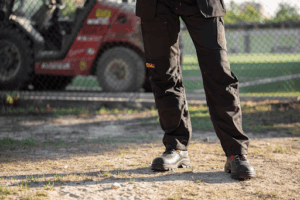Selecting the appropriate steel toe cap shoes is crucial for ensuring safety and comfort in various work environments.
Whether you’re in the construction industry, working in a warehouse, or involved in DIY projects, having the right footwear can make a significant difference.
This detailed guide aims to provide valuable insights into choosing the perfect steel toe cap shoes, focusing on trainer steel toe caps.
Brief Overview of Steel Toe Caps
Steel toe caps, also known as safety toe caps, are protective reinforcements in the toe area of shoes to safeguard against impact and compression injuries. Trainer steel toe caps combine safety features with the comfort and style of athletic shoes.
Safety Standards and Certifications
ASTM International Standards
The American Society for Testing and Materials (ASTM) sets safety standards for footwear. Look for shoes that meet or exceed ASTM F2413-18 standards for impact and compression resistance.
EN ISO Certification
EN ISO codes denote European safety standards. Ensure that the steel toe cap shoes have the EN ISO 20345:2011 certification for optimal safety compliance.
Consideration of Work Environment
A. Hazard Assessment
Conduct a thorough assessment of your work environment to identify specific hazards, such as heavy machinery, falling objects, or electrical risks.
B. Electrical Hazard Protection
If your work involves exposure to electrical hazards, choose steel toe cap trainers with additional features designed to protect against electric shocks.
C. Slip Resistance
Consider the slip resistance of the shoes, especially if you work in environments where wet or slippery surfaces are common.
Materials and Construction
A. Quality Materials
Full-Grain Leather
– Opt for shoes made from full-grain leather, a durable and high-quality material that offers excellent resistance to wear and tear.
– Leather provides breathability, allowing moisture to escape and keeping your feet comfortable.
Synthetic Materials
– Synthetic materials, such as nylon or polyester blends, are designed for durability and often offer additional features like water resistance.
– Consider synthetic options if you prefer cruelty-free or vegan footwear.
Water-Resistant Properties
– Check for water-resistant properties in the chosen materials to ensure your feet stay dry in various weather conditions.
– This feature is particularly important for those working outdoors or in wet environments.
B. Construction Techniques
Goodyear Welt
– The Goodyear welt construction method involves stitching the upper, insole, and welt together, providing durability and the option for resoling.
– This construction method is ideal for those looking for long-lasting and easily repairable footwear.
Direct Attach
– Direct attach construction directly molds the sole to the upper, offering lightweight and flexible footwear.
– Shoes with direct attach construction are comfortable for extended periods of wear.
Cement Construction
– Cement construction involves adhesive bonding the sole to the upper, providing lightweight and flexible shoes.
– While often less expensive, shoes with cement construction may not be as durable as those with Goodyear welt construction.
Comfort and Fit
A. Ergonomic Design
Look for shoes with ergonomic design features, such as padded collars, cushioned insoles, and arch support, to enhance comfort during extended wear.
B. Proper Sizing
Ensure a proper fit by measuring your feet regularly. Steel toe cap shoes that are too tight or too loose can lead to discomfort and reduced effectiveness.
Bottom Line
Choosing the right steel-toe cap shoes involves thoughtful consideration of safety standards, work environment, materials, comfort, style, and budget.
By following this detailed guide, you can make an informed decision when selecting trainer steel toe caps, ensuring both safety and satisfaction.
Remember to regularly assess and replace your footwear as needed to maintain optimal protection on the job.

